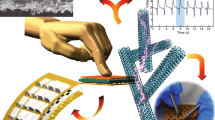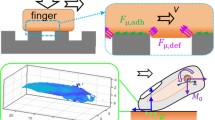Abstract.
Striving towards an in depth understanding of stimulus transformation in arthropod tactile hairs, we studied the mechanical events associated with tactile stimulation. A finite element model was developed taking a tarsal tactile hair of the spider Cupiennius salei as an example. Considering hair diameter, wall thickness, and curvature, the hair is subdivided into six regions each with its specific mechanical properties. When the hair is touched from above with a flat surface oriented parallel to the tarsus the point of stimulus contact moves towards the hair base with increasing load and hair deflection. Thereby the effective lever arm is reduced protecting the hair against breaking near its base. At the same time the mechanical working range of the hair increases implying higher mechanical sensitivity for small deflections (about 5×10–5 N/°) than for large deflections (about 1×10–4 N/°). The major stresses within the hair shaft are axial stresses due to bending. The position of stress maxima moves along the shaft with the movement of the stimulus contact point. Remarkably, the amplitude of this maximum (about 1×105 N/m2) hardly changes with increasing loading force due to the way the hair shaft is deflected by the stimulus.
Similar content being viewed by others
Author information
Authors and Affiliations
Additional information
Electronic Publication
Rights and permissions
About this article
Cite this article
Dechant, .HE., Rammerstorfer, .F. & Barth, .F. Arthropod touch reception: stimulus transformation and finite element model of spider tactile hairs. J Comp Physiol A 187, 313–322 (2001). https://doi.org/10.1007/s003590100203
Accepted:
Issue Date:
DOI: https://doi.org/10.1007/s003590100203




